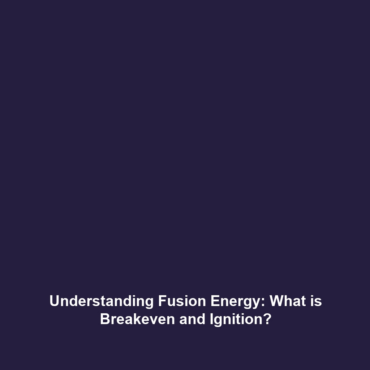The Ignition Point: A Key Concept in Fusion Energy
Introduction
A fusion reaction must produce more energy than is required to sustain it, commonly referred to as the breakeven or ignition point. This concept is pivotal in the field of fusion energy, as achieving this threshold is essential for producing viable and sustainable power. Understanding the ignition point not only highlights the potential of fusion as a clean energy source but also underlines the technological advancements necessary to harness this power. As research progresses, the implications of reaching the ignition point could revolutionize energy production and alter our reliance on fossil fuels.
Key Concepts
The ignition point in fusion reactions is defined as the critical threshold where the energy output surpasses the energy input required to initiate and maintain the reaction. This concept is rooted in several fundamental principles:
1. Energy Input vs. Output
To achieve the ignition point, the fusion reaction must overcome inertia and other energy losses. Theoretically, fusion becomes a self-sustaining reaction at breakeven, allowing for a net gain in energy.
2. Conditions for Fusion
Achieving the ignition point requires extremely high temperatures (millions of degrees Celsius) and pressures found in stellar environments. Hydrogen isotopes, such as deuterium and tritium, are typically used as fuel for these reactions due to their favorable reaction rates.
3. Plasma Confinement
Methods such as magnetic confinement (e.g., tokamaks) and inertial confinement are utilized to create conditions conducive to maintaining the fusion process. Effective confinement is crucial to achieving ignition.
Applications and Real-World Uses
The ignition point is a cornerstone of advancing fusion energy, with several promising applications:
- Energy Production: If successfully achieved, fusion can provide a near-infinite source of energy with minimal environmental impact.
- Research and Development: Understanding ignition mechanisms can lead to technological advancements in other fields, including materials science and plasma physics.
- Space Exploration: Future propulsion systems for spacecraft may utilize fusion technologies, providing higher efficiency for long-duration missions.
Current Challenges
While the ignition point offers a beacon of hope for sustainable energy, there are significant challenges:
- Technological limitations in achieving the required temperature and pressure for sustained fusion reactions.
- Stability issues in maintaining contained plasma over the necessary timeframes.
- High costs associated with research and experimental reactors aimed at achieving ignition.
Future Research and Innovations
The field of fusion energy is ripe with potential, and ongoing innovations aim to reach or exceed the ignition point:
- Advanced Tokamak Designs: New designs aim to refine plasma confinement techniques.
- AI and Machine Learning: Implementing AI will improve predictive models for plasma behavior and stability.
- International Collaborations: Projects like ITER are pivotal in sharing knowledge and resources for achieving ignition.
Conclusion
The concept of a fusion reaction reaching the ignition point is integral to the future of fusion energy. By overcoming current challenges and embracing technological innovations, the realization of sustainable fusion energy production could be on the horizon. Continued investment in research and development is crucial for making the theoretical aspects of ignition a practical reality. For those interested in further exploring the fascinating world of fusion energy, consider reading about related advancements and the ongoing debates surrounding energy policy.
